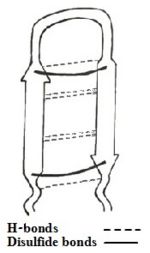Tachyplesin
From Proteopedia
(Difference between revisions)
| Line 50: | Line 50: | ||
CDT has been demonstrated to markedly inhibit the growth of Gram negative and Gram positive bacterial strains akin to TP-I. But, minimum inhibitory concentration (MIC) values for CDT were found to be lower against <i>E. Coli</i> and <i>Listeria monocytogenes</i> in comparison to the wild type TP-I peptide. | CDT has been demonstrated to markedly inhibit the growth of Gram negative and Gram positive bacterial strains akin to TP-I. But, minimum inhibitory concentration (MIC) values for CDT were found to be lower against <i>E. Coli</i> and <i>Listeria monocytogenes</i> in comparison to the wild type TP-I peptide. | ||
| - | <b> CDT Structure </b> | + | |
| + | <b><u> CDT Structure </u></b> | ||
| + | |||
CDT, like TP-1, has a β-turn in the <scene name='67/671725/Cdtturn/2'>same preserved residues</scene> in its LPS-bound structure. | CDT, like TP-1, has a β-turn in the <scene name='67/671725/Cdtturn/2'>same preserved residues</scene> in its LPS-bound structure. | ||
The β-hairpin topology of CDT is sustained by the unique packing interactions between the aromatic ring of Try2 and the sidechain of nonpolar amino acid of Val5 and the cationic sidechain of residue Arg11. | The β-hairpin topology of CDT is sustained by the unique packing interactions between the aromatic ring of Try2 and the sidechain of nonpolar amino acid of Val5 and the cationic sidechain of residue Arg11. | ||
Revision as of 20:30, 1 January 2015
Introduction
| |||||||||||
References
- ↑ 1.0 1.1 1.2 Laederach A, Andreotti AH, Fulton DB. Solution and micelle-bound structures of tachyplesin I and its active aromatic linear derivatives. Biochemistry. 2002 Oct 15;41(41):12359-68. PMID:12369825
- ↑ 2.0 2.1 PMID:11289111
- ↑ Nakamura, Takanori, et al. "Tachyplesin, a class of antimicrobial peptide from the hemocytes of the horseshoe crab (Tachypleus tridentatus). Isolation and chemical structure." Journal of Biological Chemistry 263.32 (1988): 16709-16713
- ↑ Kushibiki T, Kamiya M, Aizawa T, Kumaki Y, Kikukawa T, Mizuguchi M, Demura M, Kawabata SI, Kawano K. Interaction between tachyplesin I, an antimicrobial peptide derived from horseshoe crab, and lipopolysaccharide. Biochim Biophys Acta. 2014 Jan 2;1844(3):527-534. doi:, 10.1016/j.bbapap.2013.12.017. PMID:24389234 doi:http://dx.doi.org/10.1016/j.bbapap.2013.12.017
- ↑ 5.0 5.1 Saravanan R, Mohanram H, Joshi M, Domadia PN, Torres J, Ruedl C, Bhattacharjya S. Structure, activity and interactions of the cysteine deleted analog of tachyplesin-1 with lipopolysaccharide micelle: Mechanistic insights into outer-membrane permeabilization and endotoxin neutralization. Biochim Biophys Acta. 2012 Mar 23;1818(7):1613-1624. PMID:22464970 doi:10.1016/j.bbamem.2012.03.015
- ↑ Yonezawa A, Kuwahara J, Fujii N, Sugiura Y. Binding of tachyplesin I to DNA revealed by footprinting analysis: significant contribution of secondary structure to DNA binding and implication for biological action. Biochemistry. 1992 Mar 24;31(11):2998-3004. PMID:1372516
- ↑ Lipsky A, Cohen A, Ion A, Yedidia I. Genetic transformation of Ornithogalum via particle bombardment and generation of Pectobacterium carotovorum-resistant plants. Plant Sci. 2014 Nov;228:150-8. doi: 10.1016/j.plantsci.2014.02.002. Epub 2014 Feb, 12. PMID:25438795 doi:http://dx.doi.org/10.1016/j.plantsci.2014.02.002
Proteopedia Page Contributors and Editors (what is this?)
Shulamit Idzikowski, Janak Raj Joshi, Michal Harel, Alexander Berchansky, Joel L. Sussman, Angel Herraez, Jaime Prilusky

